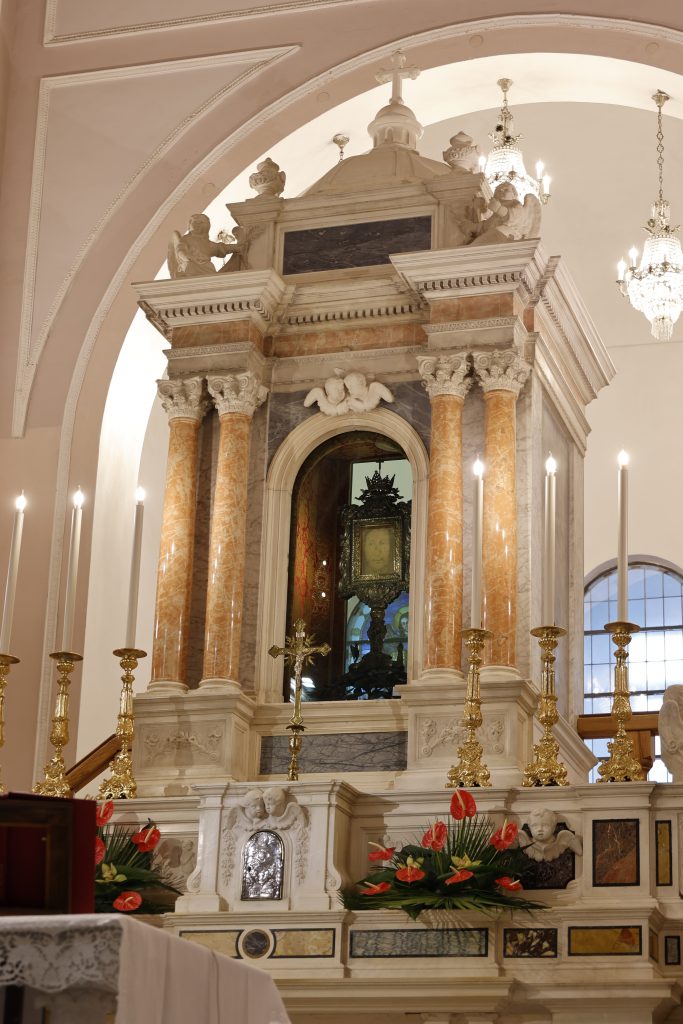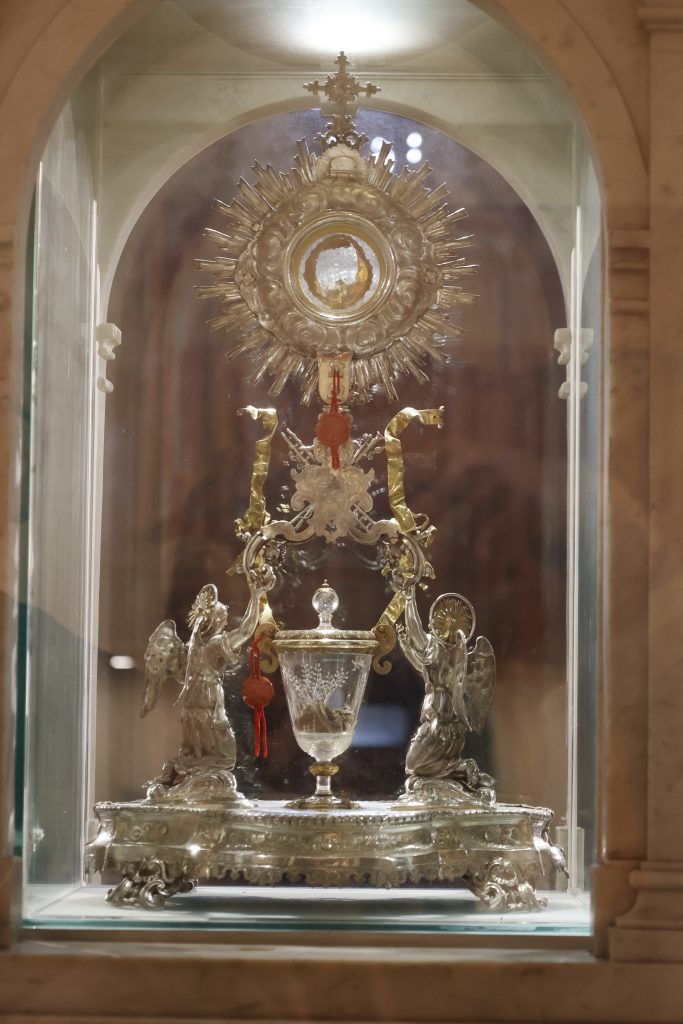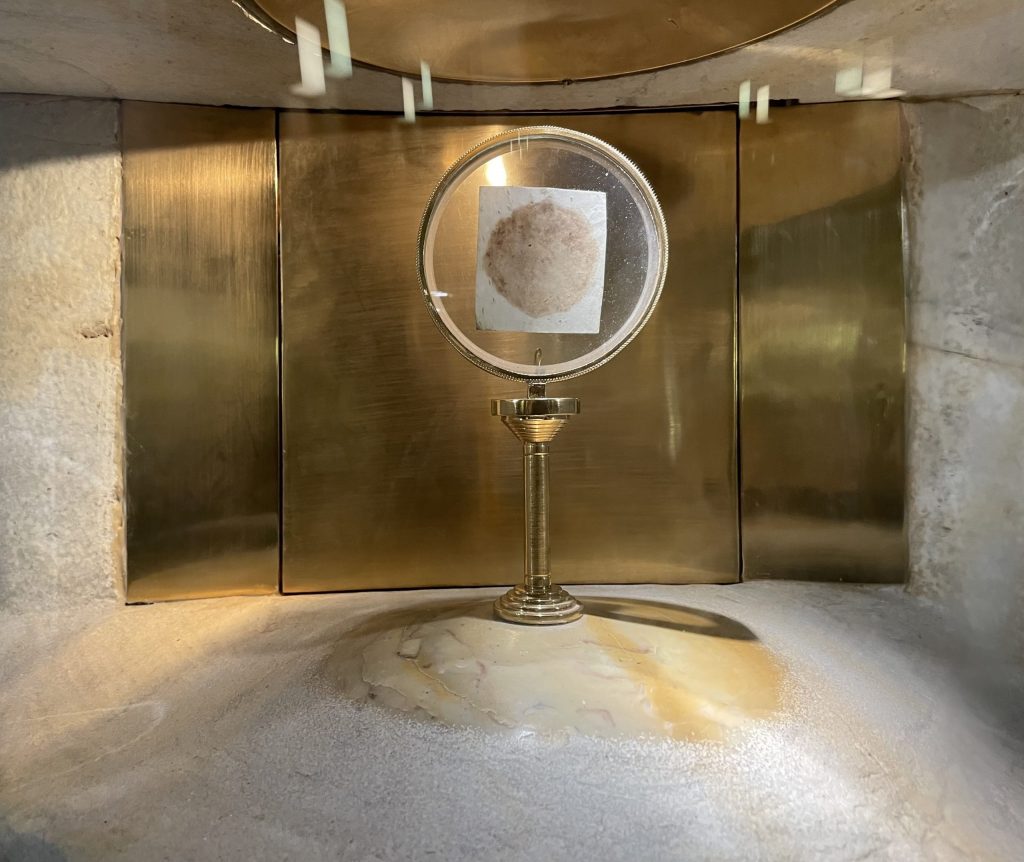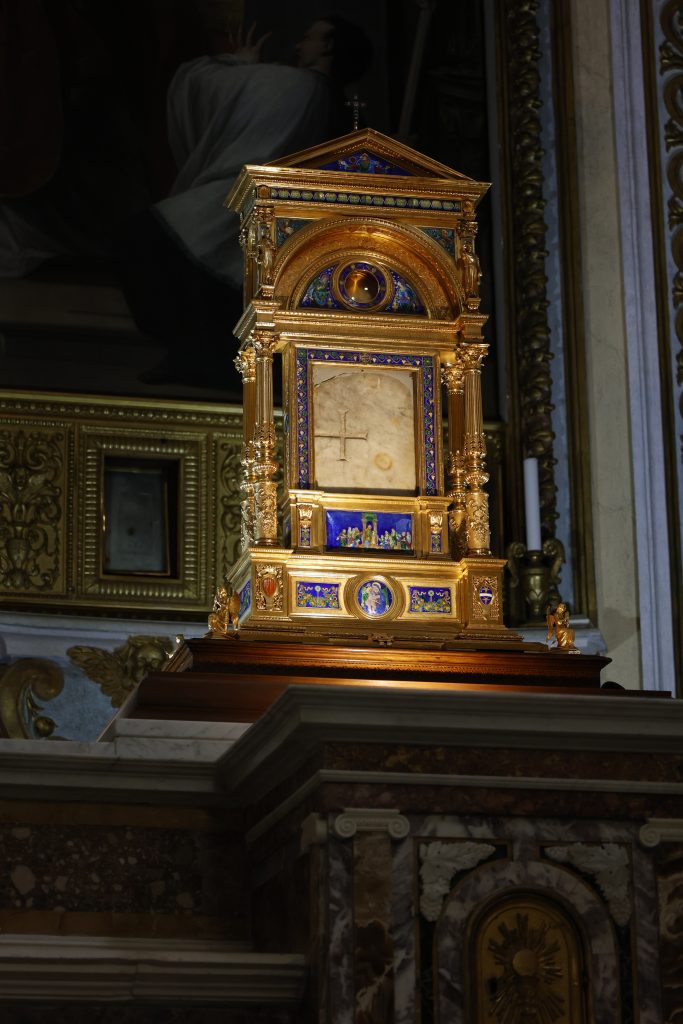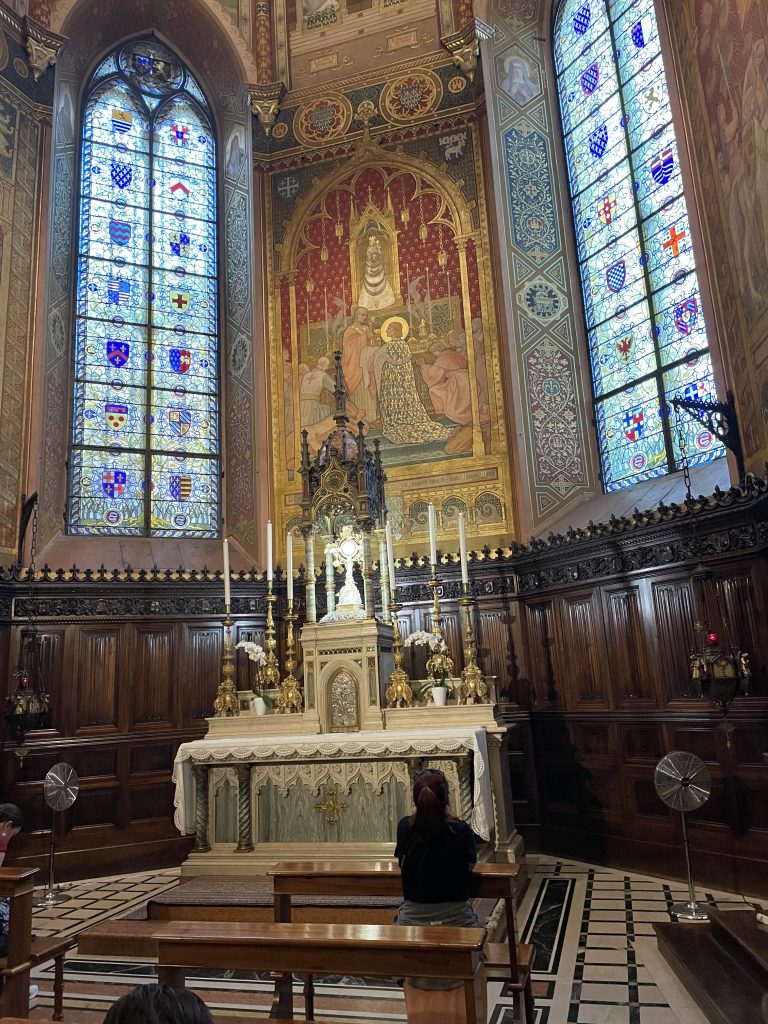October 11, 2022 // Diocese
Miracles Proof of God’s Existence, Eucharistic Presence
Miracle 1: The Veronica Veil, Manopello
Twenty-nine travel-weary pilgrims, after hours on a 787 and even more hours on a tour bus, arrive at their destination of Manoppello, located in the Abruzzo region of Italy. This village is home to a sacred and mysterious relic, the Holy Face of Jesus. The sacred cloth, made of fibers of sea silk from Mediterranean mollusks, bears an image of a bearded man with long hair. It appeared at that location in the 1500s and remained in the care of local Italian families. Now it is displayed in a glass reliquary located above the altar at the Shrine of the Holy Face of Jesus and can be viewed from in front and behind, by way of a staircase. Lights within the case, when activated, display changes in the image’s reflection.
There is some confusion that this is the veil of the saintly woman who wiped Jesus’ face on His way to the crucifixion, but the Italian guide at the church’s museum explained that the Holy Face is called the Veronica Icon, meaning the perfect icon (“vera” meaning “true”), of Jesus. When an image of the icon is superimposed on the facial image of the Shroud of Turin, the two match up perfectly – the shroud and the face covering of Jesus Christ used at His burial. While not a Eucharistic miracle per se, this is possibly the only way to view the face of Jesus this side of heaven and a good starting point for pilgrims seeking God through the Eucharist.
Miracle 2: Lanciano
In eighth-century Lanciano, a Basilian monk began to doubt the True Presence of Christ in the Eucharist. One day when celebrating the Mass, during consecration, the host was miraculously transformed into actual flesh and the wine into real blood. Testing on the flesh contained in the reliquary revealed that it is actual heart tissue, and the blood, which coagulated into five globules, is type AB, the same as that on the Shroud of Turin. The relics are kept in the Church of San Francesco in Lanciano.
Miracle 3: Cascia
This particular miracle demonstrates that a Catholic should never take the Eucharistic Host for granted. In Siena in the 1300s, a priest was called to the bedside of a dying man. In a rush to attend the man, he tucked the host inside his breviary rather than in a pyx as is proper. Upon reaching his destination, he opened his breviary and discovered that the host had bled onto the two pages, staining them with blood. One of the pages is kept in the Basilica of St. Rita in Cascia, one floor above the saint’s incorrupt body. It is said that the profile of a man’s face can be seen in the bloodstain.
Miracle 4: Siena
In 1730, thieves broke into the Church of St. Francis in Siena, stole the ciborium with all consecrated hosts inside, and fled. Two days later, the hosts were discovered in the offering box, likely placed there by the repentant bandits. The hosts, dirty from the collection box, were placed in a ciborium to allow them to deteriorate naturally. The hosts, however, never did. The still-preserved hosts are not on display, except on special occasions. They remain in the Basilica of San Francesco in Siena, where there is a display about studies done on the incorrupt hosts.
Miracle 5: Orvieta: The Miracle of Bolsena
In the Basilica of Santa Cristina in Bolsena, a similar thing happened as in Lanciano, this time to a German priest in the 13th century who had doubts about the Eucharist. At the Church of Santa Cristina, the priest celebrated Mass. During consecration, the host began to bleed, staining the corporal. The priest stopped Mass and hurriedly took the corporal to Pope Urban IV in nearby Orvieto. From the evidence of Christ’s blood on the host and the altar cloth, Pope Urban IV instituted the Solemnity of Corpus Christi.
The beautiful Cathedral of Orvieto now houses this relic. The church’s façade is covered in mosaics of gold and multiple colors and elaborate bas-relief sculptures depicting the Old and New Testaments and saints. Both the interior and exterior are striped in black and white stone and the timbered ceiling soars into the sky from rows of columns. Frescoes in the small side chapel give a visual history of the miracle and the establishment of the Solemnity of Corpus Christi.
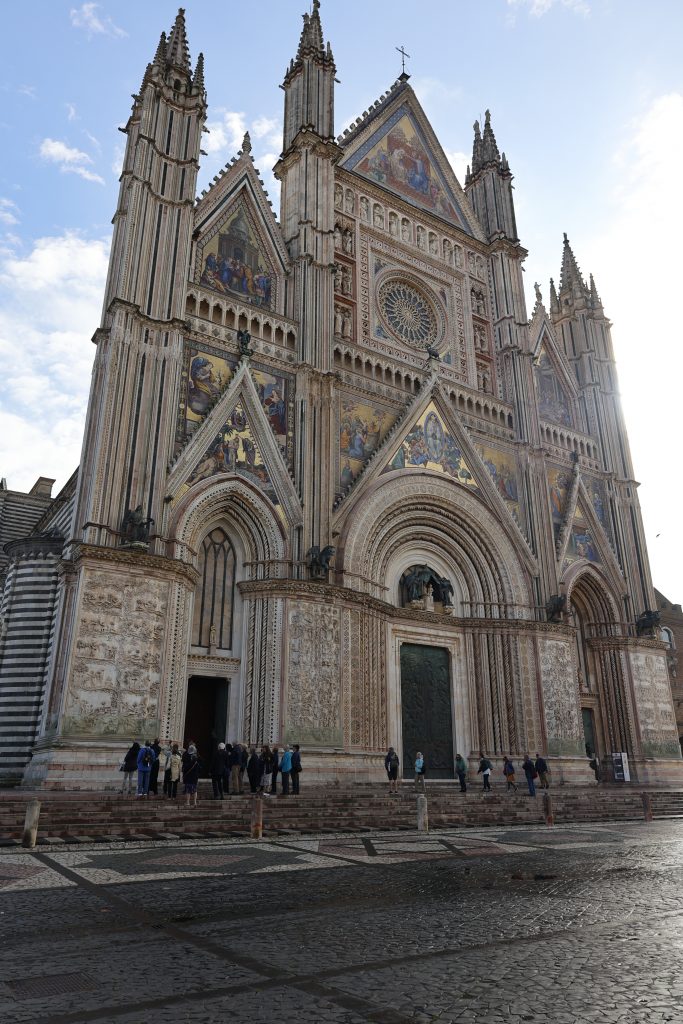
Orvieta Cathedral — Jennifer Barton
Oftentimes, relics end up in different places. In this case, the altar that the host bled onto and left bloodstains, remained in the basilica in Bolsena, while the corporal went to Orvieta Cathedral.
Seeking God in Italy
By Jennifer Barton
I recently spent nearly two weeks on a pilgrimage through the heart of Catholicism: Italy. A pilgrimage is a journey of discovery. I entered those 10 days armed with as much knowledge as I could find on things like the weather in Italy, how to dress, and how to keep my information and money safe.
I didn’t research the sites we were set to visit. I wanted to face this voyage blindly, not knowing where the road may take me and what God may have in store for me. I wanted to be a blank slate.
The expectations I had for the pilgrimage flew out the door almost before the plane left the ground at O’Hare International Airport. Expectations, after all, beg to be shattered. Travel is long and hard sometimes, as is learning the ways of a different culture. The first thing I learned about pilgrimage is that it is not a vacation.
Pilgrimages consist of early mornings and late nights (Italians eat late dinners, which can run even later if service is slow or a restaurant is crowded). Lack of sleep is a special kind of suffering to offer up for spiritual growth. In many ways, pilgrimage should hurt and it should entail suffering, as the priest leading our pilgrimage told us on more than one occasion. Losing track of the days is easy because with daily Mass, every day feels like Sunday. And each day is like walking a 5K.
Patience is the first requirement for a pilgrimage. Long bus rides, lines inside shrines and churches, periods of waiting for the group to reconvene, spending long hours with people you may not know or whose personalities contrast with yours will all test the patience of a saint, or a pilgrim, in this case. I never ask God for patience because I know He will give me opportunities to learn that particular virtue. There were plenty of these on this 10-day journey.
I also hadn’t had a great devotion to the many saints we encountered prior to this pilgrimage; I hadn’t even given them much thought before. Certainly, I knew much of their stories, but didn’t feel a deep connection to them. Strangely, at some of the holy sites where we could leave petitions, anything I previously had thought to pray for seemed to be overruled by the urge to pray for this person or that, and not leave laundry lists of petitions. Was that the nudging of these individual saints on my heart? Possibly, though who can say.
And even though I didn’t – and probably still won’t – have a deep devotion to saints like Francis and Clare, just to walk where they walked was still an immensely powerful experience. It was like a wave of wonder crashing over me. This profound feeling hit me hardest at the Holy House of Loreto, the Nazareth home where Gabriel allegedly appeared to Mary and where she raised Jesus. For some reason, Mary reached out to me there, touched my heart in such a profound, grace-filled encounter.
That left me able to stifle my misguided perceptions of people around me and gave me the strength to reject the devil’s mental promptings to feel or think in a manner contrary to Christ’s teachings during the following days. It also left me open to the grace-filled moments God had planned for me – affirming, beautiful exchanges that I needed, but was unable to receive until I let go of my pride.
A pilgrimage is a feast for the senses. Certainly, Italy can feed the needs of the stomach and taste buds, but it is so much more than that. The beauty and variety of the churches is a feast for the eyes. Assisi, with its cobbled streets worn so smooth from centuries of pilgrims treading along its paths that one could slide their feet over the ground and not trip, might have been the most beautiful Italian village I had ever seen.
Even the walls of the Holy House of Loreto, so sacred from the Presence that once filled them, are a boon to the physical sense. To touch the bricks, run your hand over their rough surfaces in wonder over the holiness that they once encased was astounding; the knowledge that these four walls once housed the Christ Child amazed us. Even feeling the smooth, damp cave walls of the catacombs where the first Christians were buried is an experience beyond words.
It is my belief that most people who undertake a pilgrimage seek something. Asking some of my fellow travelers what they sought in Italy revealed a spectrum of answers, yet all of them related to growing closer to God. I know I had my own personal spiritual reasons for going. Did we all find what we were seeking? In some ways, yes. The Eucharistic miracles that we came specifically to see had an especially profound impact on the group. Several people spoke of their reactions at being able to see these things with their own eyes; of having their belief in the True Presence confirmed beyond any doubt.
Before I left home, my parish priest advised me not to take too many pictures (in direct contrast to those who requested many photos), but he was right. As a journalist, I often see life through the lens of a camera, and here I needed to experience it, not document it all. And the priest on our pilgrimage reaffirmed that sentiment, telling me to only photograph the things God seemed to nudge me toward. Great advice.
There is still so much more to unpack, more to learn and discover from our memories of the trip, and I hope to do so in the following weeks and years as I look back. Pilgrimage can be a catalyst for growth if a person allows God to work in them through it.
I understand that not everyone can be so blessed to spend time on a pilgrimage of this magnitude, but for those who can and desire to, there are many things to keep in mind prior to pilgrimage:
You will be pulled out of your comfort zone.
You will be overwhelmed with information and awed by majesty and wonder.
You will be sleep-deprived, exhausted.
You will be footsore.
You will be blessed.
— Jennifer Barton
The best news. Delivered to your inbox.
Subscribe to our mailing list today.







